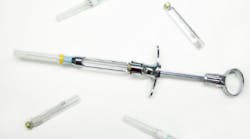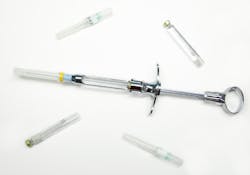When it comes to receiving dental treatment, we often hear from our patients that getting numb is a cause for concern. And let’s be honest—no one enjoys receiving an injection. The best we will hear is that someone “doesn’t mind it.” And as clinicians, we all know that anesthesia is a necessity, but one can’t help but wonder if there is any way to make the whole process of getting numb easier.
I have often wondered myself if there is any way to take the sting out of injections and lessen any of the stresses my patients are experiencing. Furthermore, is there any way to remove this stigma and improve society’s view of dentistry as a whole?
When administering anesthesia first became legal for dental hygienists in my home state of Indiana in 2008, I was very hesitant to learn this skill myself. (1)I knew how many patients disliked getting injections, and I didn’t want to be viewed as the “bad guy.” Most of my patients genuinely liked coming to see me for their care, and I didn’t want to do anything to change that perception. But as the years passed, I came to realize that I was falling behind the newest generation of dental hygienists, and I didn’t want to be lacking when it came to my job skills. Then finally, the dentist I worked for offered to reimburse me for a local anesthesia course, and I decided to bite the bullet and go for it.
During the course I learned for the first time what it felt like to receive multiple injections at one sitting (eight was the most), and it gave me a whole new respect for what patients receiving root planing and scaling routinely experience. In addition, I also learned how proficient and gentle dental hygienists can be at giving injections. When I initially began the class, I was extremely fearful of causing discomfort in other people as well as experiencing pain myself. But as I learned more about how to administer local anesthesia, my anxieties dissipated as I became accustomed to the whole classroom experience. When I left the course, my perspective about local anesthesia had completely changed and I was determined to help make the process of getting numb as easy as possible. I felt like my patients needed me more than ever to quell their fears and help them follow through with their dental treatment.
Providing anesthesia to anxious patients
When you encounter an anxious patient and you need to provide them with local anesthesia, it can be a very stressful situation for the patient as well as the dental professional. You may have concerns about the person not staying still, attempting to grab the syringe, or crying out in pain. This scenario can make a practitioner feel quite nervous, uncomfortable, and less confident while providing anesthesia. This fear is quite prevalent and should be addressed before any injections are given in order to make this experience less stressful for everyone involved.
According to a study conducted at the University of Washington, 25% of people are fearful of dental injections. (2) This anxiety even leads to one out 20 people postponing dental treatment. (2) This is issue that needs to be addressed so our patients can comfortably receive the treatment they need. There are enough barriers to care already and fear of getting local anesthesia doesn’t have to be one of them.
When this situation arises, it is best to view this scenario as an opportunity to provide your patient with a more pleasant dental experience and perhaps even change their perception of dental anesthesia. First begin by acknowledging your patients concerns and letting them know that you are going to make the injection as easy as possible for them. Let them know that you understand their concerns. Address your patient’s fear by clearly explaining what you are doing.
It may be tempting to rush through the injections in an attempt to get through the process quickly. I find that most patients feel more comfortable if you take your time. I like to explain how the injection will be more comfortable if it is given slowly and patients are very receptive to that. No one wants to feel like they are being “jabbed by a needle” and I even explain how dental needles are very narrow and glide through the tissue almost effortlessly. I often tell patients how dental needles are very flexible unlike the larger needles found in many physician’s offices. With this explanation, the patient can become confident that they are in caring hands and anxiety will hopefully begin to diminish.
As part of the comfort process, you must also be aware of your patient’s breathing, as this can be a clear sign of anxiety that must not be ignored. Medical emergencies in the dental office are most likely to occur while patients are receiving local anesthesia or shortly afterwards. (3) Sixty percent of these emergencies involve syncope, and 7% are due to hyperventilation. A normal respiration rate is 12–16 breaths per minute, so if your patient breathing is deviating from this norm, please make them aware.4 Your patient may not realize how they are breathing and taking a few moments out to avoid a potential emergency will put you both at ease.
Taking these extra measures will pay off in the end. Your patient will remember the effort involved to make sure that they are as comfortable as possible with receiving their injections. They will remember how you understood their fears and concerns.
Use needleless alternatives
One of the simplest ways to lessen the anxiety associated with local anesthesia is to avoid the needle altogether and use topical anesthesia in its place when appropriate. Some hygienists prefer to only use local anesthesia, as it will provide the patient with more complete anesthesia, but this approach does not address what the patient prefers. In many instances, topically applied Cetacaine or Oraqix provides adequate anesthesia and greatly reduces the anxiety associated with injections. (5, 6) Many patients are further relieved to learn that this type of anesthesia wears off quickly, thereby reducing the inconvenience of being numb for the next several hours.
Kovanaze nasal spray is another alternative to traditional injections that was approved by the FDA in the summer of 2016. (7) This drug is a combination of tetracaine hydrochloride and oxymetazoline hydrochloride. It provides pulpal anesthesia to teeth Nos. 4–13, or A–J in a child. Soft tissue anesthesia may also extend to the remainder of the maxillary teeth. The anesthetic effects of Kovanaze feel different than an injection, as the drug does not numb the patient’s lips, but the palate will be numb. The sensation is often described as the teeth feeling like blocks of wood. To achieve anesthesia, two syringes of Kovanaze are administered 4 minutes apart, then an additional 10 minutes’ wait is needed before treatment is initiated. Although this anesthetic is still new to the market, it may become more widely used as its price decreases and it becomes more well known as way to avoid an injection.
Let your patients be in control
When it comes to providing my patients with anesthesia for root planning and scaling, I always let them decide what type of anesthesia will work for them. I want my patients to know that they are in charge, and I want them to feel comfortable with how their treatment is performed. First, I explain the amount of buildup that is present in their mouth. Then I tell them that if I use a local anesthetic, they should be completely numb. I further explain that if I use a topical anesthetic, such as Cetacaine or Oraqix, it will lessen the tissue sensitivity, but they may still feel a little discomfort. At this point, if a patient is hesitant in deciding, I tell them that I can do the probing first and see how sensitive that is for them. If the patient is jumpy during probing, I immediately recommend using local anesthesia.
Another way to give the patient control is to be flexible with where you use which types of anesthesia. Before I knew how to provide patients with local anesthesia, the dentist always numbed the patient’s entire left or right half of the mouth when I needed to do root planning, due to the convenience factor. Then when I learned how to provide local anesthesia myself, I thought why not only numb the areas that I need to numb. I empowered my patients and let them receive less injections if I thought supplementing with Oraqix or Cetacaine was appropriate. For instance, if a patient has minimal build up on her maxillary teeth but generalized calculus on the mandibular arch, I would administer an inferior alveolar nerve block and forgo any maxillary injections. I would then simply use Oraqix or Cetacaine in the upper arch. This has worked out quite well in multiple situations and if the patient decided they wanted an injection, I could provide it immediately. The patient’s comfort level is prioritized throughout the procedure and it guarantees a less tense treatment experience.
Throughout the years, dentistry has been stigmatized as being painful. This perception has been lessened within recent years due to the advent of new technology and techniques in anesthesia. In the future, we can only hope that the connection of pain with dentistry further diminishes as we make every attempt to make anesthesia comfortable for our patients. In the end, conquering this barrier will only help us achieve our mission of providing our patients with the dental treatment they need to keep their teeth for a lifetime.
Editor's note: This article first appeared in RDH eVillage. Click here to subscribe.
References
1. Local Anesthesia Administration by Dental Hygienists – State Chart. American Association of Dental Hygienists website. https://www.adha.org/resources-docs/7514_Local_Anesthesia_Requirements_by_State.pdf
2. Milgrom P, Coldwell SE, Getz T, Weinstein P, Ramsay DS. Four dimensions of fear of dental injections. J Am Dent Assoc. 1997 Jun;128(6):756-66.
3. Hass DA. Management of medical emergencies in the dental office: Conditions in each country, the extent of treatment by the dentist. Anesth Prog. 2006 Spring; 53(1): 20–24. doi: 10.2344/0003-3006(2006)53[20:MOMEIT]2.0.CO;2. https://www.ncbi.nlm.nih.gov/pmc/articles/PMC1586863/.
4. Vital signs (body temperature, pulse rate, respiration rate, and blood pressure). Johns Hopkins Medicine website. https://www.hopkinsmedicine.org/healthlibrary/conditions/cardiovascular_diseases/vital_signs_body_temperature_pulse_rate_respiration_rate_blood_pressure_85,P00866.
5. Cetacaine topical anesthetics. Cetylite website. https://www.cetylite.com/dental/topical-anesthetics
6. Oraqix (lidocaine and prilocaine periodontal gel)2.5% / 2.5%. Dentsply Sirona website. https://www.dentsplysirona.com/en-us/products/preventive/anesthesia.html/Preventive/Anesthesia/Non-Injectable-Anesthesia/Oraqix-8lidocaine-and-prilocaine-periodontal-gel9/p/PHA-6631211020/c/1000272.html#.Wh4SSVWnHIU.
8. Kovanze. St. Renatus website. http://www.kovanaze.com.
Amber Metro-Sanchez, RDH, BA, practices dental hygiene with Dr. Chris Bible at Comfort Dental in Fort Wayne, Indiana. She also works as a professional educator on behalf of Waterpik. Amber was a member of the 2015 Colgate Oral Health Advisor Board. Amber is also a contributing author for the Colgate Oral Health Advisor webpage. She can be reached at [email protected].








